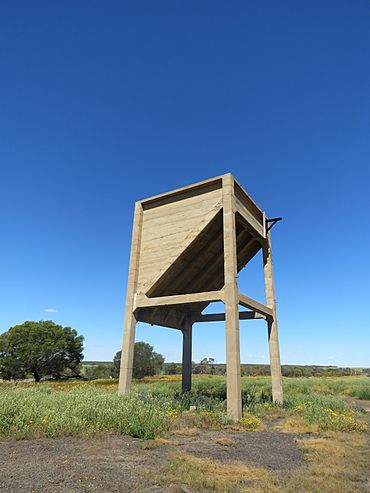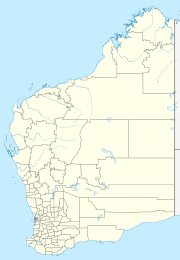Caron, Western Australia facts for kids
Quick facts for kids CaronWestern Australia |
|
|---|---|

The state heritage listed Caron Coal Stage, September 2021
|
|
| Established | 1921 |
| Postcode(s) | 6616 |
| Elevation | 324 m (1,063 ft) |
| Location | |
| LGA(s) | Shire of Perenjori |
| State electorate(s) | Moore |
| Federal Division(s) | Durack |
Caron is a small town in the Mid West region of Western Australia. It is located on the Mullewa-Wubin Road. You can find it between the towns of Perenjori and Dalwallinu.
The town gets its name from the nearby Caron Spring. This natural water source is about 26 kilometers (16 miles) to the west. Caron began as a railway station. It was part of the train line connecting Wongan to Mullewa. The townsite was officially created in 1921. The name "Caron" comes from an Aboriginal word. It means hail or hailstone.
Caron: A Small Town in Western Australia
Caron is a quiet place with an interesting history. It is known for its railway past. The town's location in the Mid West region makes it part of a large area. This area is important for farming and mining in Western Australia.
The Historic Caron Coal Stage
One of the most important landmarks in Caron is the Caron Coal Stage. This structure is listed as a heritage site. It was built during the time when steam locomotives were common. The stage was constructed around 1930 or 1931.
It is a simple concrete bin built high up. Its purpose was to hold coal. This coal was used to fuel the steam trains. The Caron Coal Stage is the only part left of the old Caron railway siding. There is also a railway dam nearby. This dam helped supply water for the trains.
Water for Trains: A Challenge
Running steam trains in Western Australia often faced a big problem: drought. Droughts meant there wasn't enough water. In 1948, a severe drought hit the region. Special trains had to bring in huge amounts of water.
About 200,000 imperial gallons (909,218 liters) of water were hauled in. This water was needed for Caron, Perenjori, and Buntine. It shows how important water was for the trains. It also highlights the challenges of operating railways in dry areas.


